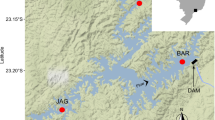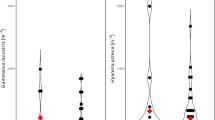Abstract
The investigation of habitat use and its relationship to phylogeny among co-occurring species provides knowledge of ecological and evolutionary parameters important for the structuring and maintenance of communities. Among communities of benthic, riffle dwelling stream fishes in the Duck River, TN, USA, we tested for interspecific separations in habitat use (i.e., based on flow velocity, substrate composition, depth, and spatial position of occurrence) to elucidate processes influential in maintaining community structure. Furthermore, we incorporated phylogeny to test for influence of evolutionary history on patterns of contemporary habitat use. Multivariate analyses recovered two significant species clusters among communities, suggesting that separations in habitat use occurred between groups of species rather than among all individual species. Phylogenetic relationships among species did not significantly correlate with species habitat use; however, we recovered patterns of displacement in habitat use among the most closely related taxa. Our results suggest that group separations in habitat use, and displacement in habitat use between close phylogenetic relatives, can help explain how communities are structured and maintained. These findings are important for understanding ecological community organization, and we demonstrate the value of examining contemporary ecological relationships in the light of evolutionary relationships.





Similar content being viewed by others
References
Blomberg, S. P., T. Garland & A. R. Ives, 2003. Testing for phylogenetic signal in comparative data: behavioral traits are more labile. Evolution 57(4): 717–745.
Burr, B. M. & R. L. Mayden, 1992. Phylogenetics and North American freshwater fishes. In Mayden, R. L. (ed.), Systematics, Historical Ecology, and North American Freshwater Fishes. Stanford University Press, Stanford: 18–75.
Carlson, R. L., P. C. Wainwright & T. J. Near, 2009. Relationship between species co-occurrence and rate of morphological change in Percina darters (Percidae: Etheostomatinae). Evolution 63(3): 767–778.
Chipps, S. R., W. B. Perry & S. A. Perry, 1994. Patterns of microhabitat use among four species of darters in three Appalachian streams. American Midland Naturalist 131: 175–180.
Clarke, K. R., 1993. Non-parametric multivariate analysis of changes in community structure. Australian Journal of Ecology 18: 117–143.
Clarke, K. R. & R. N. Gorley, 2006. PRIMER v6: User Manual/Tutorial. PRIMER-E, Plymouth.
Clarke, K. R., P. J. Somerfield & R. N. Gorley, 2008. Testing of null hypotheses in exploratory community analyses: similarity profiles and biota–environment linkage. Journal of Experimental Marine Biology and Ecology 366: 56–69.
Compton, M. & C. Taylor, 2013. Spatial scale effects on habitat associations of the Ashy Darter, Etheostoma cinereum, an imperiled fish in the southeast United States. Ecology of Freshwater Fish 22: 178–191.
Dolédec, S., D. Chessel & C. Gimaret-Carpentier, 2000. Niche separation in community analysis: a new method. Ecology 81: 2914–2927.
Douglas, M. E. & W. J. Matthews, 1992. Does morphology predict ecology? Hypothesis testing within a freshwater stream fish assemblage. Oikos 65(2): 213–224.
Edgar, R. C., 2004. MUSCLE: a multiple sequence alignment method with reduced time and space complexity. BMC Bioinformatics 5(1): 113.
Etnier, D. A. & W. C. Starnes, 1993. The Fishes of Tennessee. University of Tennessee Press, Knoxville.
Fischer, P., 2000. Test of competitive interactions for space between two benthic fish species, burbot Lota lota, and stone loach Barbatula barbatula. Environmental Biology of Fishes 58(4): 439–446.
Franssen, N. R., C. G. Goodchild & D. B. Shepard, 2015. Morphology predicting ecology: incorporating new methodological and analytical approaches. Environmental Biology of Fishes 98: 713–724.
Gorman, O. T. & J. R. Karr, 1978. Habitat structure and stream fish communities. Ecology 59: 507–515.
Greenberg, L. A., 1988. Interactive segregation between the stream fishes Etheostoma simoterum and E. rufilineatum. Oikos 51: 193–202.
Greenberg, L. A., 1991. Habitat use and feeding behavior of thirteen species of benthic stream fishes. Environmental Biology of Fishes 31: 389–401.
Guill, J. M., D. C. Heins & C. S. Hood, 2003. The effect of phylogeny on interspecific body shape variation in darters (Pisces: Percidae). Systematic Biology 52(4): 488–500.
Jackson, D. A., 1993. Stopping rules in principal components analysis: a comparison of heuristical and statistical approaches. Ecology 74: 2204–2214.
Kessler, R. K. & J. H. Thorp, 1993. Microhabitat segregation of the threatened spotted darter (Etheostoma maculatum) and closely related orangefin darter (E. bellum). Canadian Journal of Fisheries and Aquatic Science 50: 1084–1091.
Kozak, K. H., A. Larson, R. M. Bonett & L. J. Harmon, 2005. Phylogenetic analysis of ecomorphological divergence, community structure, and diversification rates in dusky salamanders (Plethodontidae: Desmognathus). Evolution 59(9): 2000–2016.
Kraft, N. J., W. K. Cornwell, C. O. Webb & D. D. Ackerly, 2007. Trait evolution, community assembly, and the phylogenetic structure of ecological communities. The American Naturalist 170(2): 271–283.
Losos, J. B., M. Leal, R. E. Glor, K. de Queiroz, P. E. Hertz, L. R. Schettino, A. C. Lara, T. R. Jackman & A. Larson, 2003. Niche lability in the evolution of a Caribbean lizard community. Nature 424(6948): 542–545.
Lundberg, J. G., M. Kottelat, G. R. Smith, M. L. J. Stiassny & A. C. Gill, 2000. So many fishes, so little time: an overview of recent ichthyological discovery in continental waters. Annals of the Missouri Botanical Gardens 87: 26–62.
Matthews, W. J., 1985. Critical current speeds and microhabitats of the benthic fishes Percina roanoka and Etheostoma flabellare. Environmental Biology of Fishes 12: 303–308.
McCune, B. & M. J. Mefford, 2011. PC-ORD. Multivariate Analysis of Ecological Data. Version 6. MjM Software, Gleneden Beach.
McGill, B. J., B. J. Enquist, E. Weiher & M. Westoby, 2006. Rebuilding community ecology from functional traits. Trends in Ecology and Evolution 21: 178–185.
Near, T. J., C. M. Bossu, G. S. Bradburd, R. L. Carlson, R. C. Harrington, P. R. Hollingsworth, B. P. Keck & D. A. Etnier, 2011. Phylogeny and temporal diversification of darters (Percidae: Etheostomatinae). Systematic Biology 60(5): 565–595.
Page, L. M., 2000. Etheostomatinae. In Craig, J. F. (ed.), Food and Feeding, in Percid Fishes: Systematics, Ecology and Exploitation. Blackwell Science Ltd., Oxford: 225–253.
Page, L. M. & D. L. Swofford, 1984. Morphological correlates of ecological specialization in darters. Environmental Biology of Fishes 11(2): 139–159.
Pease, A. A., J. M. Taylor, K. O. Winemiller & R. S. King, 2015. Ecoregional, catchment, and reach-scale environmental factors shape functional-trait structure of stream fish assemblages. Hydrobiologia 753(1): 265–283.
Poff, N. L., 1997. Landscape filters and species traits: towards mechanistic understanding and prediction in stream ecology. Journal of North American Benthological Society 16(2): 391–409.
Pratt, A. E. & T. E. Lauer, 2013. Habitat use and separation among congeneric darter species. Transactions of the American Fisheries Society 142(2): 568–577.
R Core Team, 2015. R: A Language and Environment for Statistical Computing. R Foundation for Statistical Computing, Vienna. http://www.R-project.org/. Accessed 25 July 2015.
Resetarits Jr., W. J., 2001. Experimental evidence that past predation affects community assembly: fish avoidance in a colonizing/ovipositing aquatic beetle. Oecologia 129: 155–160.
Resetarits Jr., W. J. & H. M. Wilbur, 1989. Choice of oviposition site by Hyla chrysoscelis: role of predators and competitors. Ecology 70: 220–228.
Robertson, D. R., 1996. Interspecific competition controls abundance and habitat use of territorial Caribbean damselfishes. Ecology 77(3): 885–899.
Ross, S. T., J. G. Knight & S. D. Wilkins, 1992. Distribution and microhabitat dynamics of the threatened bayou darter, Etheostoma rubrum. Copeia 1992: 658–671.
Schlosser, I. J. & L. A. Toth, 1984. Niche relationships and population ecology of Rainbow (Etheostoma caeruleum) and Fantail (E. flabellare) Darters in a temporally variable environment. Oikos 42: 229–238.
Schoener, T. W., 1974. Resource partitioning in ecological communities. Science 185: 27–39.
Stamatakis, A., 2006. RAxML-VI-HPC: maximum likelihood-based phylogenetic analyses with thousands of taxa and mixed models. Bioinformatics 22(21): 2688–2690.
Stamatakis, A., P. Hoover & J. Rougemont, 2008. A rapid bootstrap algorithm for the RAxML web servers. Systematic Biology 57(5): 758–771.
Stauffer Jr., J. R., J. M. Boltz, K. A. Kellogg & E. S. van Snik, 1996. Microhabitat partitioning in a diverse assemblage of darters in the Allegheny River system. Environmental Biology of Fishes 46: 37–44.
Vamosi, S., S. Heard, J. Vamosi & C. Webb, 2009. Emerging patterns in the comparative analysis of phylogenetic community structure. Molecular Ecology 18: 572–592.
Vandermeer, J. H., 1972. Niche theory. Annual Review of Ecology and Systematics 3: 107–132.
Warren Jr., M. L., P. L. Angermeier, B. M. Burr & W. R. Haag, 1997. Decline of a diverse fish fauna: patterns of imperilment and protection in the southeastern United States. In Benz, G. A. & D. E. Collins (eds.), Aquatic Fauna in Peril: The Southeastern Perspective. Special Publication 1, Southeast Aquatic Research Institute, Lenz Design & Communications, Decatur, GA: 105–164.
Webb, C. O., 2000. Exploring the phylogenetic structure of ecological communities: an example for rain forest trees. The American Naturalist 156(2): 145–155.
Webb, C. O., D. D. Ackerly, M. A. McPeek & M. J. Donoghue, 2002. Phylogenies and community ecology. Annual Review of Ecology Evolution and Systematics 33: 475–505.
Webb, C. O., J. B. Losos & A. A. Agrawal, 2006. Integrating phylogenies into community ecology 1. Ecology 87(sp7): S1–S2.
Welsh, S. A. & S. A. Perry, 1998. Habitat partitioning in a community of darters in the Elk River, West Virginia. Environmental Biology of Fishes 51: 411–419.
Acknowledgments
We thank E. Marsh-Matthews for her advice in the design and performance of the study. We thank E. Marsh-Matthews, W. Matthews, C. Vaughn, G. Wellborn, B. Hoagland, and J. Cureton for their comments on the manuscript. The Sam Noble Oklahoma Museum of Natural History and S. Cartwright aided in the housing and cataloging of preserved specimens. Tennessee Wildlife Resources Agency provided collection permits for this research (permit number 1651). We also thank L. Bergey for the use of borrowed field equipment. This Project was approved by IACUC No. R12-014 from the University of Oklahoma, and this manuscript is in partial fulfillment of a PhD from the Department of Biology, University of Oklahoma (ADG).
Author information
Authors and Affiliations
Corresponding author
Additional information
Handling editor: Odd Terje Sandlund
Supplement 1
PC1 and 2 showing convex hulls for all measured quadrats within each site. The +s indicate the centroid of habitat availability for each site.
Electronic supplementary material
Below is the link to the electronic supplementary material.
Rights and permissions
About this article
Cite this article
Geheber, A.D., Frenette, B.D. Separation in habitat use and phylogenetic influence on habitat use among fishes in diverse temperate stream communities. Hydrobiologia 767, 235–248 (2016). https://doi.org/10.1007/s10750-015-2504-x
Received:
Revised:
Accepted:
Published:
Issue Date:
DOI: https://doi.org/10.1007/s10750-015-2504-x




